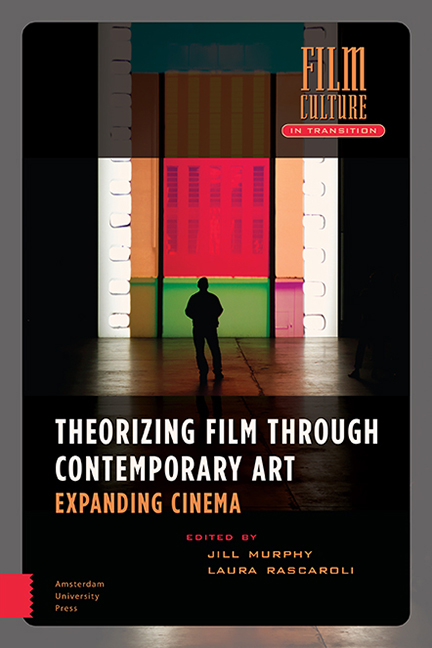Book contents
- Frontmater
- Dedication
- Contents
- List of Illustrations
- Acknowledgments
- Foreword: Courtesy of the Artists
- Introduction: On Cinema Expanding
- Part One Materialities
- 1 Cinema as (In)Visible Object; Looking, Making, and Remaking
- 2 Objects in Time; Artefacts in Artists’ Moving Image
- 3 Materializing the Body of the Actor; Labour, Memory, and Storage
- 4 How to Spell ‘Film’; Gibson + Recoder’s Alphabet of Projection
- Part Two Immaterialities
- 5 The Magic of Shadows; Distancing and Exposure in William Kentridge’s More Sweetly Play the Dance
- 6 Douglas Gordon and the Gallery of the Mind
- 7 A Throw of the Dice Will Never Abolish Chance; Tacita Dean’s Section Cinema (Homage to Marcel Broodthaers)
- Part Three Temporalities
- 8 The Photo-Filmic Diorama
- 9 The Cinematic Dispositif and Its Ghost; Sugimoto’s Theaters
- 10 Time/Frame: On Cinematic Duration
- Part Four The Futures of the Image
- 11 Interactivity without Control; David OReilly’s Everything (2017) and the Representation of Totality
- 12 Post-Cinematic Unframing
- 13 Absolute Immanence
- Index
4 - How to Spell ‘Film’; Gibson + Recoder’s Alphabet of Projection
Published online by Cambridge University Press: 23 June 2021
- Frontmater
- Dedication
- Contents
- List of Illustrations
- Acknowledgments
- Foreword: Courtesy of the Artists
- Introduction: On Cinema Expanding
- Part One Materialities
- 1 Cinema as (In)Visible Object; Looking, Making, and Remaking
- 2 Objects in Time; Artefacts in Artists’ Moving Image
- 3 Materializing the Body of the Actor; Labour, Memory, and Storage
- 4 How to Spell ‘Film’; Gibson + Recoder’s Alphabet of Projection
- Part Two Immaterialities
- 5 The Magic of Shadows; Distancing and Exposure in William Kentridge’s More Sweetly Play the Dance
- 6 Douglas Gordon and the Gallery of the Mind
- 7 A Throw of the Dice Will Never Abolish Chance; Tacita Dean’s Section Cinema (Homage to Marcel Broodthaers)
- Part Three Temporalities
- 8 The Photo-Filmic Diorama
- 9 The Cinematic Dispositif and Its Ghost; Sugimoto’s Theaters
- 10 Time/Frame: On Cinematic Duration
- Part Four The Futures of the Image
- 11 Interactivity without Control; David OReilly’s Everything (2017) and the Representation of Totality
- 12 Post-Cinematic Unframing
- 13 Absolute Immanence
- Index
Summary
Abstract
In their performances and installation work, Sandra Gibson and Luis Recoder address the specificities of cinema by investigating the event of projection. Modifying film projectors by removing essential parts and subverting the protocols of projection, the artists foreground the basic elements of cinematic articulation. Focusing primarily on Light Spill (2005) and Reduction Print (2014) and comparing them to canonical contributions to structural film, the chapter argues that the object-based and performancebased trajectories in Gibson + Recoder's work as two distinct strategies of circumscribing the media complex ‘film’ and the cultural technique of cinema. In doing so, they also provide a genuine way to re-negotiate the peculiarities of the cinema and contemporary exhibition spaces.
Keywords: Projection; structural film; medium specificity; exhibition space; modernism
Today, the term ‘moving image’ designates a confusing variety of different forms and practices. It covers analogue film in different manifestations and gauges between 8 and 70mm, a plethora of electronic video technologies, from 1960s reel-based early technologies via U-Matic to BETA, and, for at least twenty to twenty-five years, digital files of different resolution, various modes of compression, and manifold forms of circulation. The fact that the word ‘film’ serves as an umbrella term for all these formats is not very helpful since it tends to conflate the most diverse practices and economies.
If moving images were taken as a species, they would most likely drive biologists crazy since a new specimen within this expanding family seems to pop up every day. As soon as they get hold of an ‘image’ and want to start seizing and analyzing it, it multiplies and proliferates, generates sub-species, changes its form, size, and character. This situation is not new, but it has gained momentum during the last decade with digital modes of production, circulation, and reception. Everyone, it seems, now has their own moving image laboratory at home, or even in their pocket; everyone is the producer, disseminator, and recipient of moving images, everywhere, 24/7.
- Type
- Chapter
- Information
- Theorizing Film Through Contemporary ArtExpanding Cinema, pp. 101 - 120Publisher: Amsterdam University PressPrint publication year: 2020



